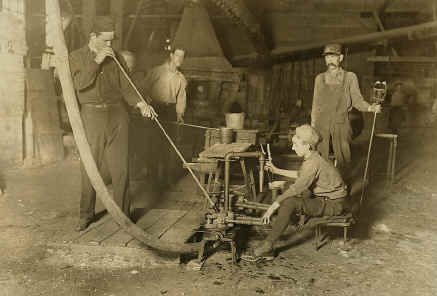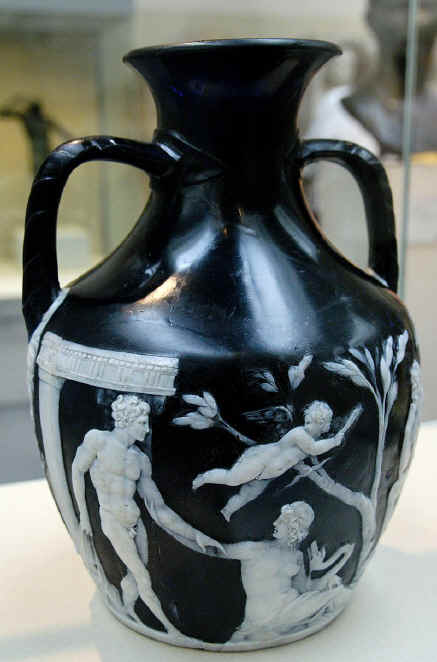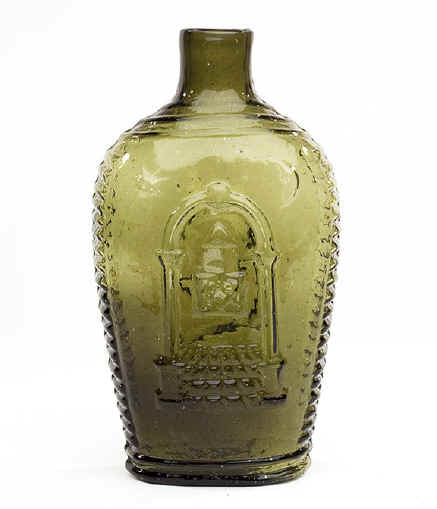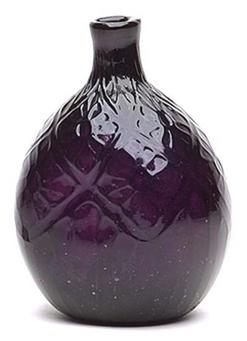|
The Origins of Glassmaking
When lightning struck sand, it creates
glass in the form fulgurites. Also known as ‘petrified lightning' or
‘lightning tubes', they form in sand and a wide variety of soils when
the moisture content is right.
The main component of regular glass is
silica, which melts at around 1650°C. Sand, generally is mostly made of
silica. The plasma generated by lightning strikes, on an average goes
well over 30,000°C.
 Volcanoes
fusing rocks with sand creates obsidian glass. It is produced when
felsic lava extruded from a volcano cools rapidly with minimal crystal
growth. Both of these natural events occurred many times before man
learned the techniques of glassmaking. Volcanoes
fusing rocks with sand creates obsidian glass. It is produced when
felsic lava extruded from a volcano cools rapidly with minimal crystal
growth. Both of these natural events occurred many times before man
learned the techniques of glassmaking.
Where and when and man first learned
to make glass is not known, but cut glass has been traced back as far as
ancient Egypt, and engraved glass to ancient Rome. Glassmaking
flourished in all the countries under Roman rule. The celebrated
Portland vase was manufactured in Rome about 70 AD. It is the best known
piece of Roman cameo glass and has served as an inspiration to many
glass and porcelain makers from about the beginning of the 18th century
onwards. It has has been in the British Museum in since 1810.
The vase is about 25 centimeters high
and 56 in circumference. It is made of violet-blue glass, and surrounded
with a single continuous white glass cameo making two distinct scenes,
depicting seven human figures, plus a large snake, and two bearded and
horned heads below the handles, marking the break between the scenes.
Glassmaking gradually spread all over
Europe, and the trade was considered to be an art of high social
standing.
The methods and ingredients used to
make glass, and the tools used to form it, have probably changed less
over the years that any other process. The earliest glass was fused in
molds to make beads or formed around sand cores to make small vessels.
The event that changed glass making the most was the introduction of the
blowpipe. Historians don’t really know when this occurred either, but
generally, it was before the birth of Christ. Since then gravity,
temperature, and constant movement of the molten material have been used
in the formation of objects of glass.
In 1608 Captain John Smith brought
glassblowers to his new colony of Virginia. A glasshouse was built on
the mainland where plenty of fuel could be obtained. It is almost
certain that green glass bottles were made there. In 1621 another
glasshouse was built in Jamestown and glassblowers were instructed to
make beads for barter with the Indians. In 1632 in his report on the new
colony of Virginia, Captain Smith said that "glas" was sent
"home." There is little doubt that glassmaking was America's
first industry.
During the 18th century, English glass
of the Queen Anne period was imported into America in unbelievable
quantities. In 1712 Bristol glass was advertised in Boston, and in 1719
there was a shop there that exclusively sold glass.
 The
first successful glass made commercially in America was that of Wistar,
a manufacturer of bottles, window glass, and other practical utensils
from 1739 to 1780, a remarkably long time for a colonial business. The
factory’s original product of brass buttons was so successful that the
plant expanded into the glassmaking field. The company was successful
enough to survive the depression years of the Revolution, and the
workmanship of the products made at Wistar’s two Southern New Jersey
plants (the other one was opened in Glassboro in 1781) became known as
South Jersey. South Jersey was usually free blown and tooled into simple
pictures, bowls and bottles. Later much of the South Jersey had
decorations of crimped and pinched bands of glass, trailing, and
quilting superimposed on it. Colors were usually those that were present
naturally, green, aquamarine and amber. The most original and inventive
technique attributed to the South Jersey workmen was the "lily
pad" motif. Blown out of the tag ends of the melting pots of green
window or bottle glass, this style was purely American and did not
pretend to imitate or compete with imported pieces. The
first successful glass made commercially in America was that of Wistar,
a manufacturer of bottles, window glass, and other practical utensils
from 1739 to 1780, a remarkably long time for a colonial business. The
factory’s original product of brass buttons was so successful that the
plant expanded into the glassmaking field. The company was successful
enough to survive the depression years of the Revolution, and the
workmanship of the products made at Wistar’s two Southern New Jersey
plants (the other one was opened in Glassboro in 1781) became known as
South Jersey. South Jersey was usually free blown and tooled into simple
pictures, bowls and bottles. Later much of the South Jersey had
decorations of crimped and pinched bands of glass, trailing, and
quilting superimposed on it. Colors were usually those that were present
naturally, green, aquamarine and amber. The most original and inventive
technique attributed to the South Jersey workmen was the "lily
pad" motif. Blown out of the tag ends of the melting pots of green
window or bottle glass, this style was purely American and did not
pretend to imitate or compete with imported pieces.
In the 1760’s, a man named Henry
Steigel began making glass in his father-in-law's ironworks. Steigel
decided to manufacture decanters and drinking glasses instead of
limiting the company to the manufacture of bottles and window glass. He
traveled to London and Bristol and studied the art of glassmaking and
hired workers trained in German, Venetian and English techniques.
Advertisements from Pennsylvania to
Massachusetts and account books show that Steigel manufactured a wide
variety of tableware, including salt, creamers,, bowls, cruets, wine
glasses, tumblers, mugs, small containers, mustard, and smelling salts
and candlesticks. His colored glass was blown into part-sized molds to
give it a pattern, and then expanded to full size and finished, a
technique called pattern-molding. Steigel engraved and enameled his
flint glass. Flint glass is crystal made of pulverized flint.
 Although
the origins of most of the patterns Steigel molded can be traced to
imitations of those used abroad, his daisy pattern is thought to have
been original. His daisies in a diamond or hexagon were mostly used on
pocket bottles. Steigel’s glass company was very successful, but when
the men of the Revolution began buying arms instead of glass, Steigel
lost everything, including his lavishly furnished mansion. Although
the origins of most of the patterns Steigel molded can be traced to
imitations of those used abroad, his daisy pattern is thought to have
been original. His daisies in a diamond or hexagon were mostly used on
pocket bottles. Steigel’s glass company was very successful, but when
the men of the Revolution began buying arms instead of glass, Steigel
lost everything, including his lavishly furnished mansion.
Another German, John Frederick Amelung,
founded the New Bremen Glass Manufactory near Frederick, Maryland in
1784. The company's clear glass decanters, glasses and goblets were
shallow wheel engraved, frequently bore commemorative inscriptions, and
set a high standard for the company's competitors.
The first glass factory west of the
Alleghenies was Albert Gallatin’s New Geneva Glassworks in western
Pennsylvania. In 1797 some of Amelung’s craftsmen migrated to Gallatin’s
Glasshouse near Pittsburgh. The availability of coal helped this area to
develop into a great manufacturing region.
After that, many important glasshouses
were founded in midwestern areas, including Zanesville, Ravenna, Mantua
and Kent, in Ohio.
Bakewell and Company of Pittsburgh was
established in 1808, and employed skilled English and Irish cutters. Its
cut and engraved glass rivaled the quality of imported glass. In
addition, Bakewell also manufactured free-blown and molded wares both
clear and in colors. Bakewell followed trends in both products and
patterns, and became one of the most diversified manufacturers of glass
in the century.
The early 18th century had many more
glass factories, and some of these, like the 1818 New England Glass
Company of East Cambridge, Massachusetts, and the Boston and Sandwich
Glass Company of Cape Cod in 1825 became giants in the industry.
White Bakewell’s and the New England
Glass Company were producing glass in the best European traditions,
America took the lead in improvements in glass making techniques, like
mechanical pressing. Because of American inventions of the late 1820s,
glass could be pressed in a hand-operated mold into elaborately stippled
pieces, known today as "lacy glass." Simple molds manually
pressed together were made into salt cellars and cup plates,
inexpensively imitating cut glass.
 The
second type of glass developed in America, was blown three-mold glass,
which also imitated the more expensive cut glass. In this process, the
blower expanded his gather of glass within a three-part mold, hinged to
a base, until it filled the pattern of the mold, some of which had cut
glass patterns incised on them. After the mold was opened, the piece was
manipulated with tools if further decoration was desired. Blown
three-mold pieces were produced in glass houses from New England to Ohio
in both clear and colored glass, and some in bottle glass. The
second type of glass developed in America, was blown three-mold glass,
which also imitated the more expensive cut glass. In this process, the
blower expanded his gather of glass within a three-part mold, hinged to
a base, until it filled the pattern of the mold, some of which had cut
glass patterns incised on them. After the mold was opened, the piece was
manipulated with tools if further decoration was desired. Blown
three-mold pieces were produced in glass houses from New England to Ohio
in both clear and colored glass, and some in bottle glass.
Among the most popular American
mold-blown objects was the historical flask, ornamented with political
figures, national heroes, and popular slogans. They were made throughout
the 19th century, and remain as a pictorial of history. The American
eagle appeared more frequently than any other motif; Masonic emblems and
political slogans were often used.
Shortly after the beginning of the
19th century, another technique developed around Pittsburgh,
pattern-molded glass. The shape and pattern of this ware was formed by
blowing the gather into part-sized dip, an open top, one piece mold, or
hinged molds. After it was removed from the mold, further blowing
expanded the glass into the desired size. The pattern, impressed by the
mold, spread out into a soft outline. Ribbed, swirled and diamond
patterns where the most popular designs. The "broken-rib" was
made by dipping the gather into the mold twice. After the gather was
blown into a rib mold, it was removed, given a twist, and blown into the
mold a second time. Then it was removed from the mold and expanded into
a flask or dish.
The earliest known examples of
American cut glass date from 1711 and they were of simple designs, like
stars in geometric designs. Engraving was also done in America. Fruit
and floral designs were the most popular, as were classical swags and
festoons. After the engraving, the pieces were hand-polished on wooden
wheels, thus giving them a soft luster distinct from the later
high-speed wheel polishing or acid bath. Fine cut designs were made by
Amelung Bakewell, the New England Glass Company, and the Boston &
Sandwich Glass Company.
By 1830, the American glass industry
had become so well established that it no longer had to depend on
foreign imports, and high tariffs were levied on glass from Europe. The
Baldwin Bill of 1830 that levied the tariffs, created a boom in American
glass manufacture so great that to historians, the Colonial Period of
American glass manufacture came to an end. It was now time for America's
glass industry to create its own style.
Illustrations from top to bottom:
A) "Glass Blower and Mold Boy. Grafton, W. Va." (Library of
Congress)
B) EXOGENIC FULGURITES, ELKO COUNTY, NEVADA Wedding scene, detail of the
side A of the Portland Vase
C) Masonic Historical Flask, Coventry Glass Works, Coventry,
Connecticut, 1824 – 1826
D) Attributed to Henry William Stiegel, Diamond Daisey Bottle, 1767-84.
Blown amethyst glass. Courtesy Yale University Art Gallery
|